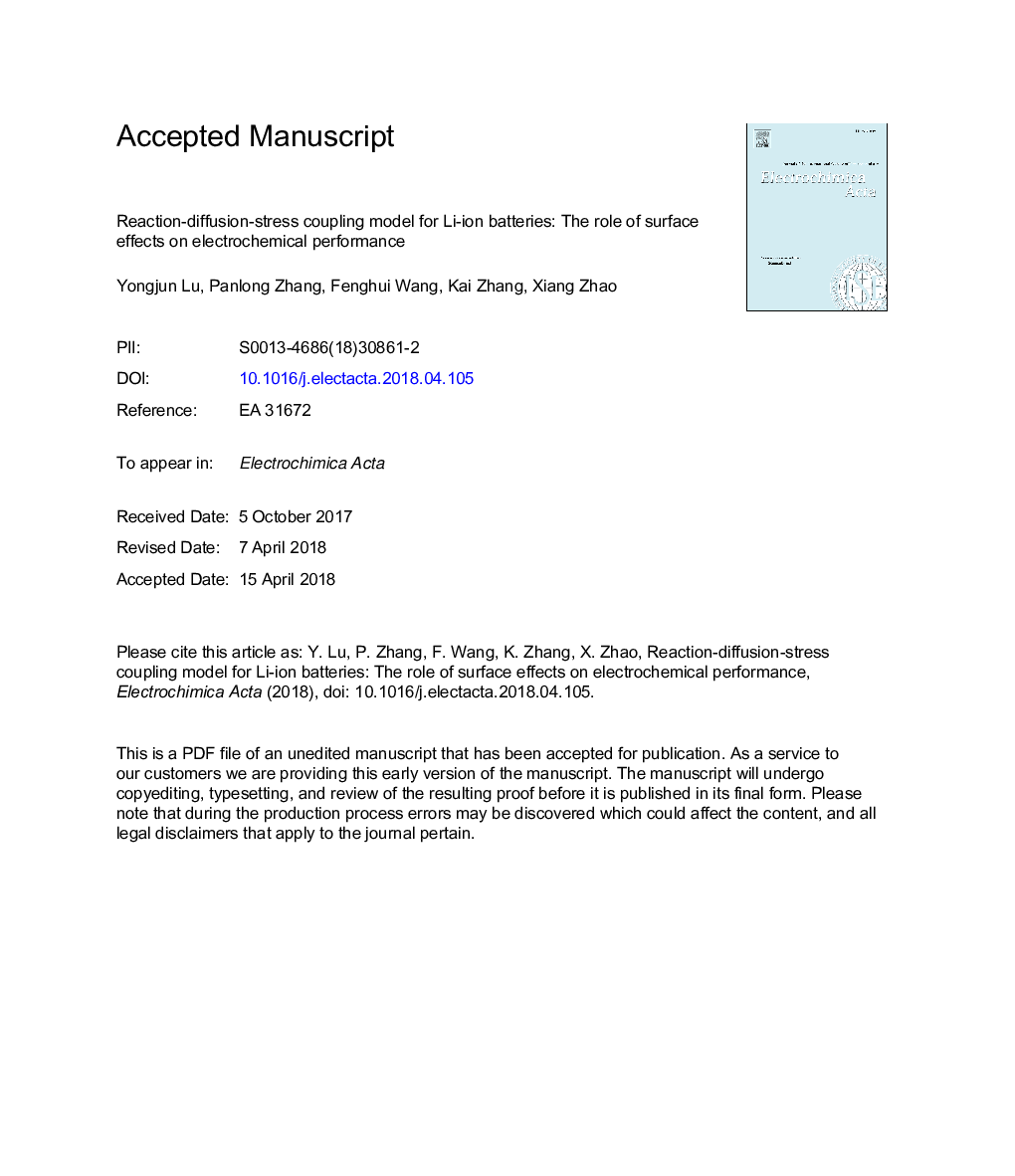| کد مقاله | کد نشریه | سال انتشار | مقاله انگلیسی | نسخه تمام متن |
|---|---|---|---|---|
| 6603101 | 1424083 | 2018 | 50 صفحه PDF | دانلود رایگان |
عنوان انگلیسی مقاله ISI
Reaction-diffusion-stress coupling model for Li-ion batteries: The role of surface effects on electrochemical performance
ترجمه فارسی عنوان
مدل اتصال واکنش-انتشار-استرس برای باتری های لیتیوم یون: نقش اثرات سطحی بر عملکرد الکتروشیمیایی
دانلود مقاله + سفارش ترجمه
دانلود مقاله ISI انگلیسی
رایگان برای ایرانیان
کلمات کلیدی
باتری های لیتیوم یون، واکنش الکتروشیمیایی، نفوذ، کشش سطحی، الکترود نانوساختار،
ترجمه چکیده
در سال های اخیر، طراحی نانوساختار برای الکترودهای باتری به عنوان یک راه حل امیدوار کننده برای بهبود توانایی سرعت و قابلیت اطمینان الکترودهای با ظرفیت بالا ظهور کرده است. با این حال، اثرات سطح ناشی از اندازه ویژگی های کوچک ممکن است بر ویژگی های چند فیزیکی الکترودهای تحت شرایط چرخه الکتروشیمیایی غیر تعادل تاثیر بگذارد. در این مطالعه، یک مدل اتصال واکنش-دیفرانسیل-استرس با سهم اثرات سطحی ایجاد شده است که می تواند تعاملات بین واکنش الکترود سطحی، انتشار و تغییر شکل جامد را در یک نانوذره ی الکترود تحت شار و تخلیه غیر سیگنال غیر تعادل ببیند. نتایج عددی نشان می دهد که استرس فشاری در سطح ذرات الکترود در هنگام ورود، جذب لیتیوم را مهار می کند، در حالی که تنش کششی در سطح ذرات الکترود به علت استخراج یون، باعث کاهش جذب لیتیوم با توجه به واکنش های الکتروشیمیایی سطح می شود. هنگامی که مکانیک سطح به بررسی الکترود نانو محسوب می شود، کشش سطحی باعث افزایش ثبات مکانیکی می شود و همچنین کاهش قابل توجه ظرفیت شارژ در طی عملیات گالوانواستات و پتانسیواستاتیک را در بر می گیرد. با ارائه بیشتر اثرات مدول سطح قابل تنظیم، نشان داده شده است که مدول سطح مثبت، افتادگی شارژ را تشدید می کند، در حالی که مدول سطح منفی آن را برای یک پتانسیل داده شده مناسب می کند. نتایج این تحقیق، یک ایده جدید برای مهندسی نانو را برای بهینه سازی طراحی الکترود جهت دستیابی به دوام لازم و عملکرد الکتروشیمیایی فراهم می کند.
موضوعات مرتبط
مهندسی و علوم پایه
مهندسی شیمی
مهندسی شیمی (عمومی)
چکیده انگلیسی
Recent years, nanostructured design for battery electrodes has emerged as a promising solution to improve rate capability and reliability of the high-capacity electrodes. However, the surface effects arising from small feature size may affect the multi-physical features of electrodes subject to non-equilibrium electrochemical cycles. In this study, a reaction-diffusion-stress coupling model is developed with the contribution of surface effects, which can capture the interactions between surface electrode reaction, diffusion and solid deformation in a nanoparticle of an electrode under non-equilibrium cyclic charge and discharge. Numerical results show that compressive stress at the surface of an electrode particle during insertion inhibits lithium absorption, while tensile stress at the surface of an electrode particle due to ion extraction suppresses lithium desorption with regard to surface electrochemical reactions. When surface mechanics is taken account into nanoscale electrode study, surface tension is found to be responsible for the increase in mechanical stability, as well as the significant reduction in charge capacity during both the galvanostatic and potentiostatic operation in the meantime. By further introducing tunable surface modulus effects, it is shown that the positive surface modulus aggravates charge capacity loss, whereas the negative surface modulus remedies it for a given potential. The results of the study provide a new idea for nano-surface engineering to optimize the design of electrode to meet required durability and electrochemical performance.
ناشر
Database: Elsevier - ScienceDirect (ساینس دایرکت)
Journal: Electrochimica Acta - Volume 274, 1 June 2018, Pages 359-369
Journal: Electrochimica Acta - Volume 274, 1 June 2018, Pages 359-369
نویسندگان
Yongjun Lu, Panlong Zhang, Fenghui Wang, Kai Zhang, Xiang Zhao,
